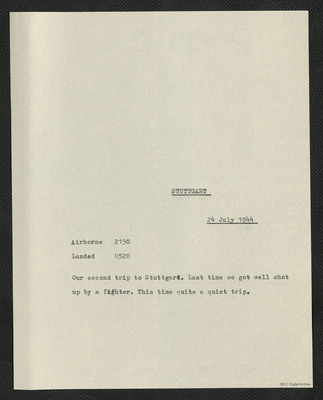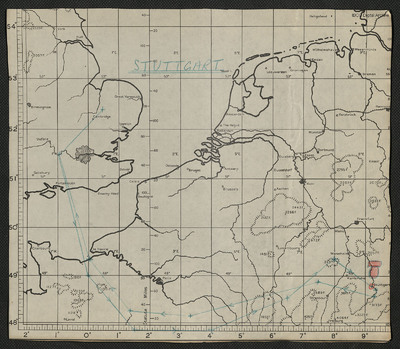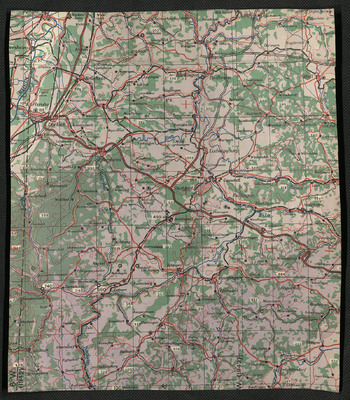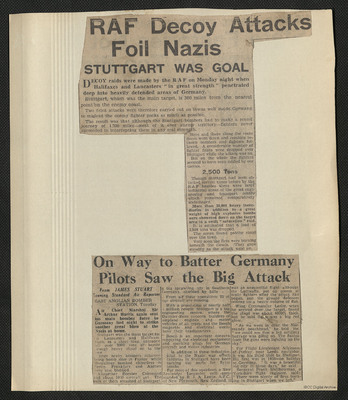Stuttgart, Edward King's 29th operation of his tour
Title
Stuttgart, Edward King's 29th operation of his tour
Description
A very brief description of the operation, his navigation plot and a map showing the target. There are also some newspaper clippings, one showing the damage to Stuttgart and others giving comments from bomber crew members when taking part in a raid on Stuttgart.
Creator
Date
1944-07-24
1944-07-25
Language
Format
Five items, a description of the operation, a navigation plot, a map, and two newspaper clippings
Conforms To
Publisher
Rights
This content is available under a CC BY-NC 4.0 International license (Creative Commons Attribution-NonCommercial 4.0). It has been published ‘as is’ and may contain inaccuracies or culturally inappropriate references that do not necessarily reflect the official policy or position of the University of Lincoln or the International Bomber Command Centre. For more information, visit https://creativecommons.org/licenses/by-nc/4.0/ and https://ibccdigitalarchive.lincoln.ac.uk/omeka/legal.
Contributor
Identifier
SKingEJ182986v10142, SKingEJ182986v10143, SKingEJ182986v10144, SKingEJ182986v10146, SKingEJ182986v10148
Transcription
[UNDERLINED]STUTTGART [/UNDERLINED]
[Underlined] 24 July 1944 [/underlined]
Airborne 2150
Landed -520
Our second trip to Stuttgart. Last time we got well shot up by fighters. This time quite a quiet trip.
[Page Break]
[Route Map]
[Inserted][underlined] STUTTGART [/underlined][/inserted]
[Inserted][underlined] T [/underlined][/inserted]
[Page Break]
[Navigation Plot Map]
[Page Break]
[Photograph]
STUTTGART. After three heavy attacks by aircraft of Bomber Command at the end of July, 1944, large areas of the city were left devastated. This photograph shows the central area, about 50 acres, S.W. of the main station where many public building have been gutted or entirely destroyed.
34 35
[Page Break]
[Newspaper article]
RAF DECOY ATTACKS
FOIL NAZIS
STUTTGART WAS GOAL
Decoy raids were made by the RAF on Monday night when Halifaxes and Lancasters “in great strength” penetrated deep into heavily defended areas of Germany.
Stuttgart, which was the main target, is 300 miles from the nearest point on the enemy coat.
Two feint attacks were therefore carried out on towns well inside Germany to mislead the enemy fighter packs as much as possible.
The result was the although the Stuttgart bombers had to make a round journey of 1,700 lies – most of it over enemy territory – fighters never succeeded in intercepting them in any real strength.
Here and there along the route flares went down and fighters followed. A considerable number of fighter flares were dropped over Stuttgart while the attack was on.
But on the whole the fighters seemed to have been misled by our tactics.
2,500 Tons
Through Stuttgart had been attacked several times before by the RAF heavies there were large industrial area of the great engineering and transport centre which remained comparatively undamaged.
More than 30,000 heavy incendiaries on addition to a great weight of high explosive bombs were showered down on the target area in a swift “Saturation” raid.
It is estimated that a load of 2,500 tons were dropped.
The crew found patchy cloud over the town.
Very soon the fires were burning beneath the clouds. They grew steadily as they attack went on.
On Way to Batter Germany Pilots Saw the Big Attack
[Italics] From JAMES STUART Evening Standard Air Reporter [/Italics]
EAST ANGLIAN BOMBER STATION. Tuesday
Air chief Marshall Sir Arthur Harris again sent his main bomber force to Germany last night to strike another blow at the Nazis at home.
Stuttgart was the main target for the Lancasters and Halifaxes which, in a short time unloaded well over 2000 tons of bombs through heavy cloud on to the town.
Other heavy bombers attacked lying bomb sites in France while Mosquitoes bombed objective in Berlin, Frankfurt and Aachen were also bombed.
Although Bomber Command had about 1000 aircraft out. The bulk of them smashed Stuttgart,
A big sprawling city in Southern Germany, shielded by hills.
From all these operations 23 of our aircraft are missing.
With a population of nearly half a million people Stuttgart is a big engineering centre, where the Daimler-Benz concern builders of airplane engines and motor vehicles of all types and the Bosch magnetos and electrical works have their headquarters.
Bosch is and important concern supplying the electrical equipment and sparking plugs for German aircraft and motor industries.
In addition to these industries vital to the Nazis war effort factories in Stuttgart have been turning our parts for flying bombs.
For most of this squadron a New Zealander Lancaster unity commanded by R.J.A. Leslie, A.F.C., of New Plymouth, New Zealand, it was an uneventful flight although Luftwaffe put up scores of night fighters after the attack had begun, and the ground defences poured up a heavy volume of flak.
Wing Commander Leslie, when he arrived over the target, found the cloud was about 4000ft. thick but he said there was a big red glow,
“As we went in over the Normandy beachhead,” he told me, “We could see that a big artillery barrage was going on. The flashes from guns were lighting up the sky.”
For Flight Lieutenant Atkinson, of Pudsey, near Leeds navigator, it was his third visit to Stuttgart. His first was on 1938 – on holiday to Germany. “It was a beautiful old city in those days.” He said.
Sergeant Frank Matthewman a Yorkshire flight engineer, said : “There were plenty of fires burning in Stuttgart when we left.”
[Underlined] 24 July 1944 [/underlined]
Airborne 2150
Landed -520
Our second trip to Stuttgart. Last time we got well shot up by fighters. This time quite a quiet trip.
[Page Break]
[Route Map]
[Inserted][underlined] STUTTGART [/underlined][/inserted]
[Inserted][underlined] T [/underlined][/inserted]
[Page Break]
[Navigation Plot Map]
[Page Break]
[Photograph]
STUTTGART. After three heavy attacks by aircraft of Bomber Command at the end of July, 1944, large areas of the city were left devastated. This photograph shows the central area, about 50 acres, S.W. of the main station where many public building have been gutted or entirely destroyed.
34 35
[Page Break]
[Newspaper article]
RAF DECOY ATTACKS
FOIL NAZIS
STUTTGART WAS GOAL
Decoy raids were made by the RAF on Monday night when Halifaxes and Lancasters “in great strength” penetrated deep into heavily defended areas of Germany.
Stuttgart, which was the main target, is 300 miles from the nearest point on the enemy coat.
Two feint attacks were therefore carried out on towns well inside Germany to mislead the enemy fighter packs as much as possible.
The result was the although the Stuttgart bombers had to make a round journey of 1,700 lies – most of it over enemy territory – fighters never succeeded in intercepting them in any real strength.
Here and there along the route flares went down and fighters followed. A considerable number of fighter flares were dropped over Stuttgart while the attack was on.
But on the whole the fighters seemed to have been misled by our tactics.
2,500 Tons
Through Stuttgart had been attacked several times before by the RAF heavies there were large industrial area of the great engineering and transport centre which remained comparatively undamaged.
More than 30,000 heavy incendiaries on addition to a great weight of high explosive bombs were showered down on the target area in a swift “Saturation” raid.
It is estimated that a load of 2,500 tons were dropped.
The crew found patchy cloud over the town.
Very soon the fires were burning beneath the clouds. They grew steadily as they attack went on.
On Way to Batter Germany Pilots Saw the Big Attack
[Italics] From JAMES STUART Evening Standard Air Reporter [/Italics]
EAST ANGLIAN BOMBER STATION. Tuesday
Air chief Marshall Sir Arthur Harris again sent his main bomber force to Germany last night to strike another blow at the Nazis at home.
Stuttgart was the main target for the Lancasters and Halifaxes which, in a short time unloaded well over 2000 tons of bombs through heavy cloud on to the town.
Other heavy bombers attacked lying bomb sites in France while Mosquitoes bombed objective in Berlin, Frankfurt and Aachen were also bombed.
Although Bomber Command had about 1000 aircraft out. The bulk of them smashed Stuttgart,
A big sprawling city in Southern Germany, shielded by hills.
From all these operations 23 of our aircraft are missing.
With a population of nearly half a million people Stuttgart is a big engineering centre, where the Daimler-Benz concern builders of airplane engines and motor vehicles of all types and the Bosch magnetos and electrical works have their headquarters.
Bosch is and important concern supplying the electrical equipment and sparking plugs for German aircraft and motor industries.
In addition to these industries vital to the Nazis war effort factories in Stuttgart have been turning our parts for flying bombs.
For most of this squadron a New Zealander Lancaster unity commanded by R.J.A. Leslie, A.F.C., of New Plymouth, New Zealand, it was an uneventful flight although Luftwaffe put up scores of night fighters after the attack had begun, and the ground defences poured up a heavy volume of flak.
Wing Commander Leslie, when he arrived over the target, found the cloud was about 4000ft. thick but he said there was a big red glow,
“As we went in over the Normandy beachhead,” he told me, “We could see that a big artillery barrage was going on. The flashes from guns were lighting up the sky.”
For Flight Lieutenant Atkinson, of Pudsey, near Leeds navigator, it was his third visit to Stuttgart. His first was on 1938 – on holiday to Germany. “It was a beautiful old city in those days.” He said.
Sergeant Frank Matthewman a Yorkshire flight engineer, said : “There were plenty of fires burning in Stuttgart when we left.”
Collection
Citation
Edward King, “Stuttgart, Edward King's 29th operation of his tour,” IBCC Digital Archive, accessed October 29, 2024, https://ibccdigitalarchive.lincoln.ac.uk/omeka/collections/document/34202.
Item Relations
This item has no relations.





